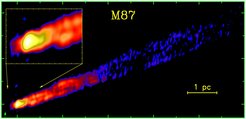Fifty Times sharper than Hubble
New Image of the Central Region of the Active Galaxy M87

The observations were performed with the Very Long Baseline Array (VLBA) of the National Radio Astronomy Observatory (NRAO), consisting of ten radio antennas in North America including Hawaii and Virgin Island and an additional telescope from the Very Large Array (VLA) near Socorro, New Mexico. The Effelsberg 100m radio telescope is regularly used for transatlantic baselines extending the VLBA observations. "With the 100m radio telescope, we plan to increase the spatial resolution and provide an even more detailed image of the M87 jet", says Yuri Kovalev.
M87 is a very massive galaxy (2 to 3 x 1012 solar masses) and the central object of the Virgo cluster of galaxies at a distance of only 16 Megaparsec (approximately 50 million light years). "The first jet-like structure, emanating from the nucleus of a galaxy, was found in M87", says NRAO co-author Ken Kellermann, former MPIfR director and currently external member of the institute. In 1918, US astronomer Heber Curtis was the first to discover a nuclear jet extending at least 5000 light years from the center of M87. This galaxy was also among the first to be recognized as a powerful source of radio emission. John Bolton and his colleagues from Australia used the sea cliff interferometer in Sydney to identify the strong radio source Virgo A with the galaxy M87 (published 1949 in "Nature").
The energy of such powerful radio galaxies results from their "central engines". Active Galactic Nuclei or AGN are thought to consist of a very massive black hole in the center of the galaxy, in case of M87 a black hole of approximately 3 billion (3 x 109) solar masses. A disk of rapidly rotating gas around the nucleus (accretion disk) "feeds" the black hole and matter is ejected from the nucleus in jets orthogonal to the disk.
From a theoretical point of view, Russian astrophysicist Iosif Shklovsky argued already in 1964, that such jets in powerful radio galaxies, feeding the double radio lobes in objects like Cygnus A or Virgo A, were likely to be intrinsically two-sided. The one-sided appearance of most of the observed jets, suggested Shklovsky, might be due to relativistic Doppler beaming, increasing the luminosity of the jet in the direction of the observer. "With our new observations, we could indeed confirm the faint counter-jet structure in M87 and thus give a proof for Shklovsky's theoretical assumptions", says Yuri Kovalev who got his PhD in Russia, in a research group originally founded by Shklovsky.
At present Kovalev works a a Research Fellow of the Alexander von Humboldt Foundation in the Very Long Baseline Interferometry (VLBI) group of MPIfR in Bonn. "Its a nice result to see both, jet structure and jet dynamics of this nearby radio galaxy in such fine detail", says Anton Zensus, director at MPIfR and head of the VLBI research group.
